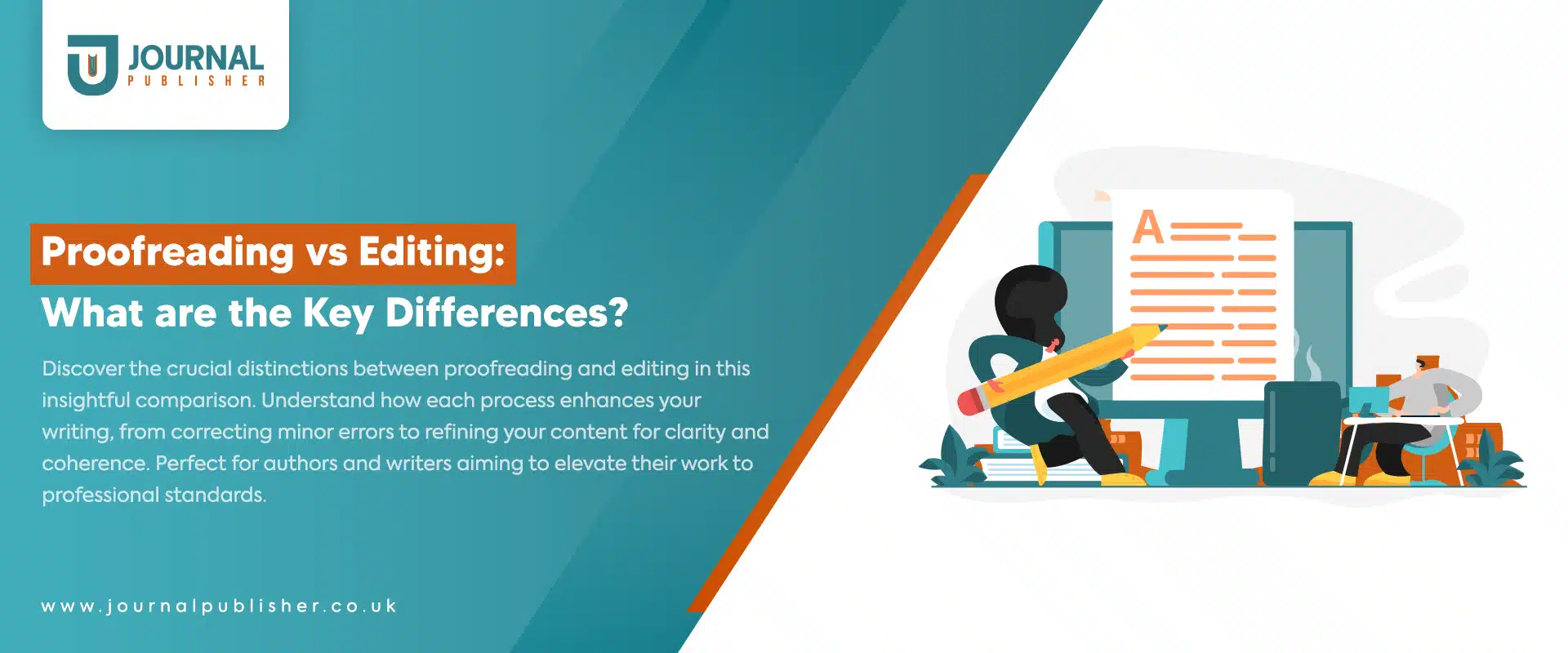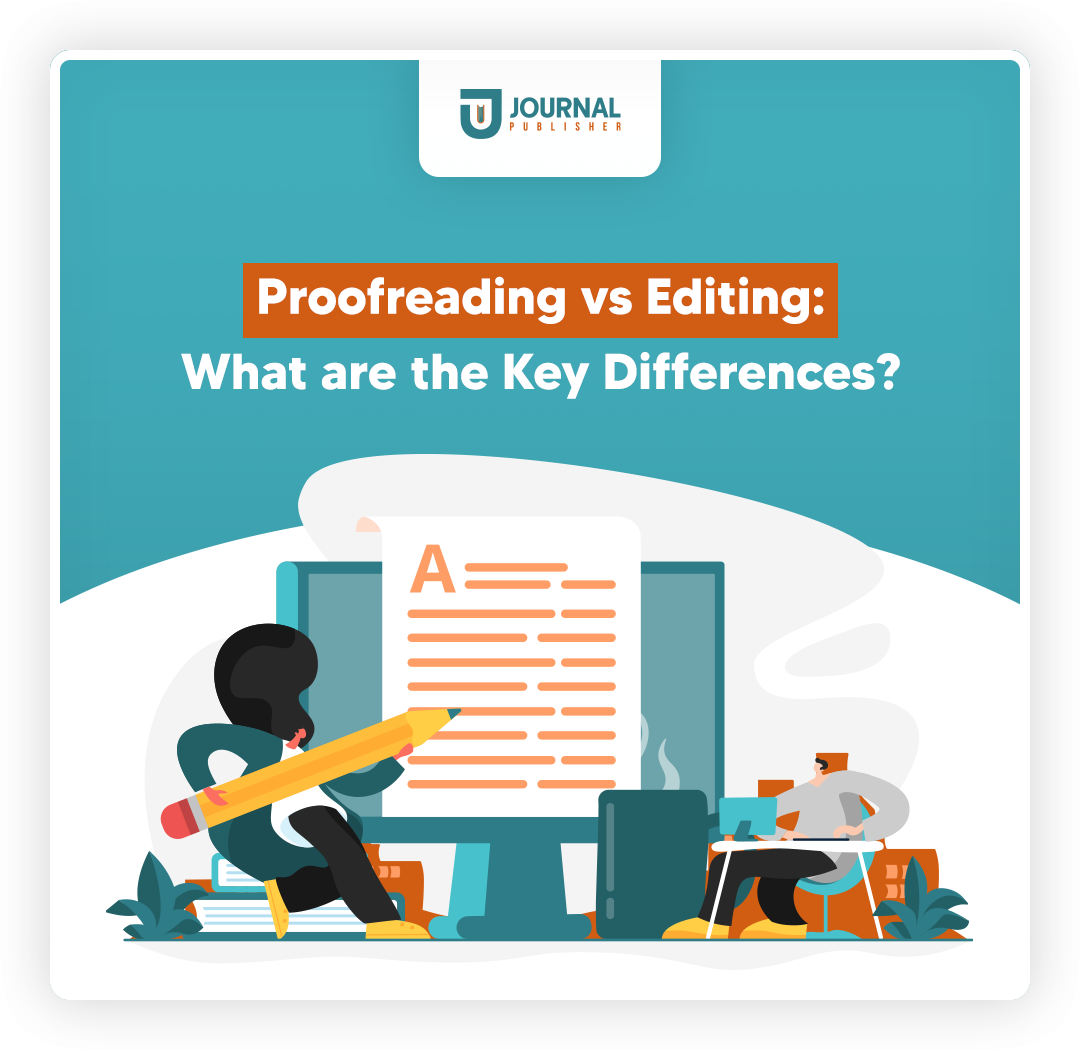Author: Layla Taylor |  8 min read
8 min read
Don’t Have Time to Read? Listen to this Article Instead!
Key Takeaways: Proofreading vs Editing: What are the Key Differences?
Quickly learn proofreading vs editing differences.
Proofreading:
- Proofreading is where you correct minor errors such as spelling, grammar, and punctuation.
- It is the final step before publishing.
- Proofreaders ensure your work is polished and ready for readers. But they don’t make big changes to content.
Editing
- Editing goes deeper. It improves the overall content, structure, and clarity of your writing.
- It is where you revise the content for flow and coherence.
- Editors refine the overall tone and message.
Make Your Manuscript Error-Less
Our expert proofreaders will polish your research. We ensure it meets the highest standards. Let us help you achieve publication success.
Introduction: Proofreading vs Editing
Have you ever spent hours crafting a perfect sentence and found a glaring error later? That’s where editing and proofreading come in. Writing is a form of art. At the same time, editing and proofreading are the skilled artisans who refine it.
Once you’ve completed your essay or research proposal, you might be unsure what to choose between proofreading vs editing. Therefore, you should know the difference between these two, especially if you’re a professional writer or working on academic projects.
So, it is imperative to know which one is best for your work. Indeed, it can prevent you from embarrassment and ensure your writing is perfect and effective. In this article, you will learn all about editing vs proofreading. We will explain what each one is and how they are different.
What is Proofreading?
The word “proofread” is a mix of two words: “proof” and “read.”
Proof: This refers to a trial or test, often used to check the accuracy or quality of something before it is ready to summit.
Read: This is the act of looking at and understanding written or printed material.
When combined, “proofread” means to carefully read something to check for errors or mistakes before you submit or publish.
What Does A Proofreader Do?
Proofreaders are the final line of defence. So, they ensure your document or piece of writing is error-free. Their primary task is to identify and correct surface-level mistakes such as:
- Spelling
- Grammar
- Punctuation
- Capitalization
- Formatting
On the other hand, they may also flag potential issues in your content, such as structure. In such cases, they will highlight the problem. They can also provide specific feedback to the writer. Proofreaders do not make substantive changes to the content. Their role is to ensure that the writing is clear, concise, and error-free.
Key Info:
“There are different types of proofreading. Each can help you according to your content type.
What is Editing?
The word “edit” comes from the Latin word “editio”. It means “putting forth” or “giving out”. This is related to the idea of preparing something for publication or presentation. Over time, the meaning of “edit” has evolved to include the act of changing or revising something. So, now it is often used to say “improving the content, style, or accuracy”.
What Does an Editor Do?
Editors play a major role and make your overall document quality better. They are not like proofreaders who just focus on surface-level errors. Editors dig deep into the substance of the work. They examine the style and coherence to ensure the content is clear and well-structured.
Editors specifically look for:
- Clear and easy-to-follow ideas that make sense.
- A well-organized story with a good flow and pace.
- The right tone, style, and voice match the audience and purpose of the writing.
- Repeated words or ideas could make the writing less powerful.
Expert Editing for Successful Publication
Our expert editors can help you polish your work to perfection. Let Journal Publisher ensure your work impresses your journal as well as readers.
Proofreading vs Editing: Key Differences
When it comes to refining a written piece, you can use the terms “proofreading” and “editing” interchangeably. But, they refer to two distinct stages in the writing process. Both involve improving a text. However, they focus on different aspects. Also, they are performed at various stages of the revision process.
Editing
Editing is the process that takes a closer look at the overall structure and clarity of a text. An editor’s role is to ensure that the document is coherent and effectively conveys the intended message. This stage of revision is more about shaping and refining the content.
It also makes sure that the content aligns with the goal of your writing. Editing is like sculpting; it’s about changing the raw material into finished goods. Editors do not just fix mistakes. They enhance the overall quality of the writing.
Proofreading
Proofreading, on the other hand, is the final step before publication. This process is more focused on basic issues. It ensures that the text is free from errors and inconsistencies. As a result, the document gets polished, professional, and ready for readers.
| Feature | Editing | Proofreading |
| Who | Writers seeking to improve the overall quality of their work. | Writers who want to ensure it is error-free before submission. |
| When | During the writing process and after completing early drafts. | Immediately before submission or publication. |
| What | Check clarity, coherence, style, and tone. | Focuses on correcting errors in grammar, punctuation, spelling, and formatting. |
| Time and cost | Can be a time-consuming process. Costs vary depending on the editor’s experience and the scope of the project. | Typically a quicker process. Costs are generally lower than editing. |
What are The Roles Of Editors and Proofreaders?
The Role of an Editor
Editors are in charge of the overall quality and coherence of your content. They typically work with the first draft of a document and make vital changes to improve its structure and style.
There are several types of editors, such as:
- Content editors: Focus on the overall structure and consistency of the content.
- Line editors: Pay close attention to the sentence-level details. Also, it includes style, tone, and clarity.
- Copy editors: Mainly focus on correcting errors in grammar, punctuation, as well as style.
- Mechanical editors: Ensure the document follows specific style guides or formatting standards.
The Role of a Proofreader
Proofreaders are the final line of defence before a document is ready to submit. So, they typically work with the last draft of the document. They focus on the technical aspects of the writing.When to Hire a Proofreader?
You should pick a proofreader when:
- You need a fresh pair of eyes because it is possible that an experienced writer can overlook errors.
- Your document has a significant impact, such as a cover letter, academic paper, or legal document. Then, it is worth hiring a proofreader to ensure it is error-free.
- You don’t know about your grammar or punctuation. In this case, a proofreader can help you avoid mistakes that could undermine your message.
- You need to meet a deadline. In this case, proofreaders can often turn around documents quickly.
When to Hire an Editor?
Suppose your document requires major changes in terms of readability and structure. In that case, it is vital to hire an editor. Secondly, you are unsure about message delivery. They can help you convey your thoughts more effectively. Last but not least, if your writing is difficult to follow, the editor can suggest changes to improve the flow of your text.
Key Takeaway:
“While some online editing services offer proofreading as a separate service, some bundle it with their editing packages. A few specialize solely in proofreading.”
Why is Proofreading Important?
Proofreading makes sure your work is accurate and follows the guidelines. Not only that, it also helps you identify and correct errors in grammar, spelling, and punctuation.
Why is Editing Important?
Editing is vital because it ensures the overall quality and effectiveness of your work. When you edit your text, you make the words easier to understand. This provides your content with a logical structure and clarity.
“Whether you need thesis editing or dissertation editing, we provide both. Contact us and make your academic work perfect with us.”
Conclusion
Both editing and proofreading are crucial steps in the writing process. But they serve different purposes. Editing focuses on the overall content issue, such as structure. On the other hand, proofreading looks at basic grammar issues. So, it is vital to understand the difference between proofreading vs editing processes. As a result, it will help you produce higher-quality writing and avoid childish mistakes. If you are still confused, you can contact Journal Publisher to help you pick the right services.
Frequently Asked Questions
What should be done first, editing or proofreading?
Firstly, you should do the editing part. Once you've improved the overall quality of the content, you can then focus on the finer details of proofreading.
What is the difference between line editing and proofreading?
Line editing is a type of editing that focuses on the sentence level. Proofreading checks errors at the word level, such as typos and spelling mistakes.
Do proofreaders make edits?
Yes, proofreaders can make edits, but their primary focus is on correcting errors. They might make changes to things such as:
- Grammar
- Punctuation
- Spelling
- Formatting
Don’t miss this video – it’s packed with valuable information!
Credit:Instant Assignment Help Australia
Ensure Your Research Paper is Perfect
Our editors have vast experience editing research papers in every field. We can make your research ready for publication.





